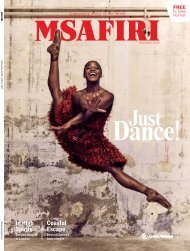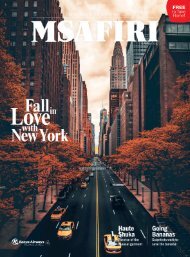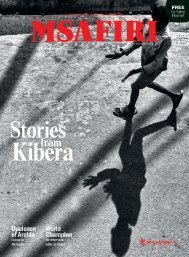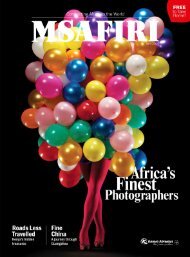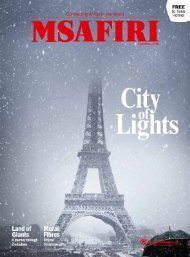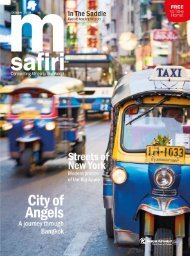Create successful ePaper yourself
Turn your PDF publications into a flip-book with our unique Google optimized e-Paper software.
66 / HERITAGE / Afrofuturism<br />
HERITAGE WILDLIFE / 67<br />
Alamy<br />
“If you’re going to imagine yourself<br />
in the future, you have to imagine<br />
where you’ve come from”<br />
WHO WOULDN’T WANT to visit<br />
Wakanda, the fictional world of the film,<br />
Black Panther? Here, a king leads a lush,<br />
technologically advanced African nation<br />
that has never been colonised, and<br />
whose teen princess is the genius who<br />
runs the nation’s science programme<br />
while designing fashionable armour.<br />
Wakanda also has war rhinos. Grossing<br />
over US$1.3 billion worldwide, Black<br />
Panther captured the cultural zeitgeist.<br />
It also sparked renewed interest in<br />
“Afrofuturism”, which opens the door<br />
for black creators to enter the world of<br />
science fiction (sci-fi). This genre often<br />
features allegories for real life, emphasising<br />
important issues facing society.<br />
Afrofuturism provides the same platform<br />
for African-Americans to bring<br />
their iconography, language, history,<br />
myth and lore to craft powerful stories.<br />
Album artwork for<br />
Janelle Monáe’s album<br />
Dirty Computer.<br />
JUCO Photo / Art & Motion<br />
THE INCITING INCIDENT<br />
Cultural critic Mark Dery coined<br />
the term in his 1994 essay, Black to the<br />
Future. It featured conversations with a<br />
sci-fi writer, a fellow critic and an academic<br />
to explore the ways in which sci-fi<br />
is uniquely suited to tell the truths of the<br />
forced alienation of black people in the<br />
US. But it’s also a moving dialectic that<br />
achieves something more: through a<br />
telling discussion between Dery and<br />
Samuel R. Delany (the sci-fi writer) it<br />
shows how Afrofuturism also promotes<br />
humanity and the individuals within it,<br />
not the subjugated races it has become.<br />
In his earlier works, Delany deliberately<br />
downplayed the issue of race, for<br />
which he received some criticism. But he<br />
had a good reason for doing so. “Now<br />
part of what… I see as the problem is the<br />
idea of anybody’s having to fight the fragmentation<br />
and multicultural diversity of<br />
the world… by constructing something so<br />
rigid as an identity, an identity in which<br />
there has to be a fixed and immobile<br />
core… that is structured to hold inviolate<br />
such a complete biological fantasy as race<br />
– whether black or white,” he says. Delany<br />
was one of only a handful of black<br />
people who wrote sci-fi back in the mid<br />
1990s, yet his writing sits with the work<br />
of sci-fi behemoths like his friend and<br />
peer William Gibson, who wrote the<br />
cyberpunk thriller Neuromancer.<br />
HIDDEN IN PLAIN SIGHT<br />
Dery identified a broad range of<br />
artists whose work bore elements of<br />
Afrofuturism: “Glimpses of it can be<br />
caught in Jean-Michel Basquiat paintings<br />
Black Panther’s cultural references<br />
Director Ryan Coogler’s choices in costume and architecture can be traced back to actual<br />
geographical locations and communities. This gives curious Africans in the diaspora who’ve<br />
never travelled to the continent actual reference points to existing tribes, cultures and practices<br />
that they can be proud to associate with. The Queen’s crown is from the Zulu in South Africa; the<br />
force-field blankets, Lesotho; the mining tribe’s bulbous clay-moulded hairstyles are indigenous to<br />
Namibia’s Himba tribe, while lip extension is practiced by groups in Chad, Tanzania, Mozambique<br />
and Ethiopia. The three main leads; Black Panther, Nakia and Okoye had a hidden message: they<br />
wore black, green and red, respectively. These are the colours of the Pan-African flag.<br />
such as Molasses, which features a pieeyed,<br />
snaggletoothed robot; in movies<br />
such as John Sayles’s The Brother from<br />
Another Planet and Lizzie Borden’s<br />
Born in Flames; in records such as Jimi<br />
Hendrix’ Electric Ladyland and George<br />
Clinton’s Computer Games.” He also<br />
lauded composer, keyboardist and<br />
poet, Sun Ra and his “intergalactic<br />
big-band jazz”. In the 1950s, Sun Ra<br />
merged Egyptian mythology with<br />
cosmic philosophy and performed on<br />
stage in bold and stylish African-themed<br />
spacesuits. Sun Ra is now widely<br />
regarded as a pioneer of Afrofuturism.<br />
Tricia Rose, the academic interviewed<br />
by Dery, explains Sun Ra’s approach,<br />
“If you’re going to imagine yourself in<br />
the future, you have to imagine where<br />
you’ve come from; ancestor worship in<br />
black culture is a way of countering a<br />
historical erasure.” Indeed, Africans<br />
were essentially robbed of their heritage<br />
during the transatlantic slave trade, so<br />
it stands to reason that regaining it<br />
should be of paramount importance,<br />
and therefore, that it should feature<br />
heavily in Afrofuturist productions.<br />
(See text box on Black Panther.)<br />
Invisible Man by Ralph Ellison,<br />
which is regarded as an early work of<br />
Afrofuturism, references that historical<br />
deletion by showing the unjust consequences<br />
black people have since endured.<br />
This 1953 National Book Award winner<br />
features an unnamed protagonist<br />
reflecting on the various ways he’d<br />
experienced social invisibility. “The<br />
opening and closing scenes of Invisible<br />
Man hold forth the possibility of a<br />
different relationship between technology,<br />
race, and art: by hiding out under New<br />
York City and stealing electricity to<br />
power his turntables, Ellison’s protagonist<br />
creates a space outside linear time<br />
where he can begin to rewire the relations<br />
between past and present and art and<br />
technology,” writes Lisa Yaszek in her<br />
essay, An Afrofuturist Reading of Ralph<br />
Ellison. >



